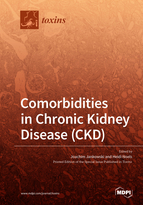Comorbidities in Chronic Kidney Disease (CKD)
A special issue of Toxins (ISSN 2072-6651). This special issue belongs to the section "Uremic Toxins".
Deadline for manuscript submissions: closed (31 March 2020) | Viewed by 63747
Special Issue Editors
Interests: chronic renal failure; hypertension; proteomics; mediator identification; mass-spectrometry; chromatography; pathophysiology of kidney diseases
Special Issues, Collections and Topics in MDPI journals
Special Issue Information
Dear Colleagues,
Cardiovascular disease causes 47% of all deaths in Europe, 10% of Europeans suffer from chronic kidney disease, and 5–8% of elderly aged 60 years or older have to live with cognitive impairment. This disease trio is associated with end-organ damage in the kidney, heart, vasculature, and brain and displays as highly frequent comorbidities. Specifically, ~45% of patients with chronic kidney disease stage 4–5 die from cardiovascular disease, and chronic kidney disease and cardiovascular disease raise the risk of cognitive impairment 2–2.5-fold. Of note, risks of cardiovascular disease and cognitive impairment increase with chronic kidney disease severity but are already significantly higher in early chronic kidney disease compared to non-chronic kidney disease.
Chronic kidney disease, cardiovascular disease, and cognitive impairment are most likely triggered by common pathological molecular mechanisms, with chronic kidney disease further amplifying pathological triggers for co-developing cardiovascular disease and cognitive impairment, which is already present at an early stage (chronic kidney disease stage 1–3). This Special Issue will focus on both causative molecular and cellular mechanisms for diagnosis and prognosis of cardiovascular disease and cognitive impairment in chronic kidney disease, as well as biomarkers for diagnosis, prognosis, and monitoring of comorbid patients.
Prof. Dr. Joachim Jankowski
Dr. Heidi Noels
Guest Editors
Manuscript Submission Information
Manuscripts should be submitted online at www.mdpi.com by registering and logging in to this website. Once you are registered, click here to go to the submission form. Manuscripts can be submitted until the deadline. All submissions that pass pre-check are peer-reviewed. Accepted papers will be published continuously in the journal (as soon as accepted) and will be listed together on the special issue website. Research articles, review articles as well as short communications are invited. For planned papers, a title and short abstract (about 100 words) can be sent to the Editorial Office for announcement on this website.
Submitted manuscripts should not have been published previously, nor be under consideration for publication elsewhere (except conference proceedings papers). All manuscripts are thoroughly refereed through a double-blind peer-review process. A guide for authors and other relevant information for submission of manuscripts is available on the Instructions for Authors page. Toxins is an international peer-reviewed open access monthly journal published by MDPI.
Please visit the Instructions for Authors page before submitting a manuscript. The Article Processing Charge (APC) for publication in this open access journal is 2700 CHF (Swiss Francs). Submitted papers should be well formatted and use good English. Authors may use MDPI's English editing service prior to publication or during author revisions.
Keywords
- Cardiovascular disease
- Chronic renal failure
- Cognitive impairment
- Molecular mechanisms
- Molecular mediators
- Pathway analyses
- Age and gender aspects
- In vitro/ex vivo analyses
- Proteomics
- Therapy







